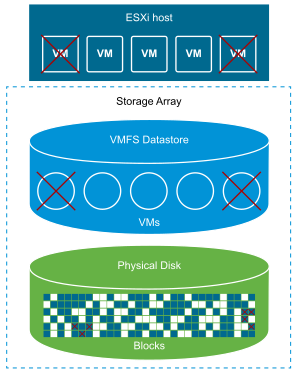ESXi supports the space reclamation command, also called SCSI unmap command or NVMe dataset management deallocate command, that originates from a VMFS datastore or a VM guest operating system. The command helps thin-provisioned storage arrays to reclaim unused space from the VMFS datastore and thin virtual disks on the datastore. The VMFS6 datastore can send the space reclamation command automatically. With the VMFS5 datastore, you can manually reclaim storage space.
For information about space reclamation with the Virtual Volumes datastores, see Reclaim Space on the vSphere Virtual Volumes Datastores.
You free storage space inside the VMFS datastore when you delete or migrate the VM, consolidate a snapshot, and so on. Inside the virtual machine, storage space is freed when you delete files on the thin virtual disk. These operations leave blocks of unused space on the storage array. However, when the array is not aware that the data was deleted from the blocks, the blocks remain allocated by the array until the datastore releases them. VMFS uses the SCSI unmap command to indicate to the array that the storage blocks contain deleted data, so that the array can unallocate these blocks.

The command can also originate directly from the guest operating system. Both VMFS5 and VMFS6 datastores can provide support to the unmap command that proceeds from the guest operating system. However, the level of support is limited on VMFS5.
Depending on the type of your VMFS datastore, you use different methods to configure space reclamation for the datastore and your virtual machines.
Watch the following video to learn more about how space reclamation works.